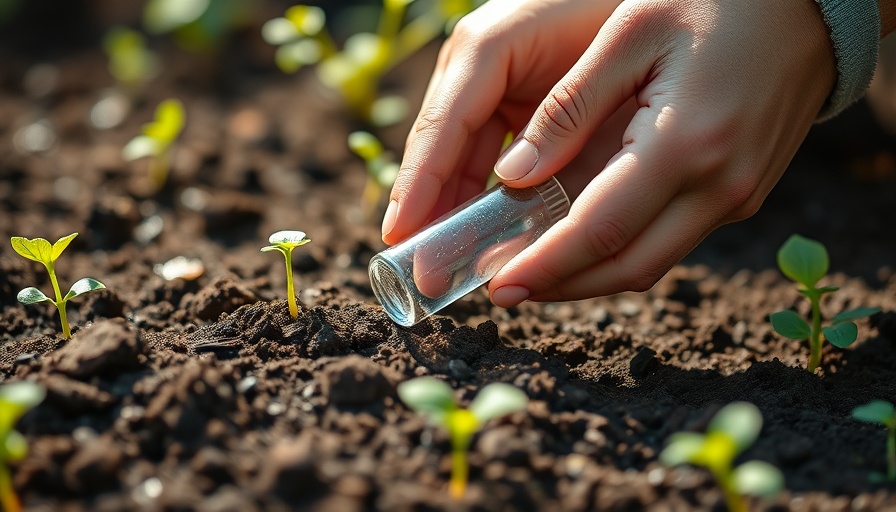
Unveiling the Secrets Beneath Your Feet: The Importance of Soil Testing
Gardening enthusiasts are often caught up in the excitement of planting vibrant flowers or bountiful vegetables, yet many overlook the critical foundation of their gardening success: the soil. Soil testing is not just beneficial; it is essential. Just as athletes analyze their performance metrics to improve, gardeners must delve into the metrics of their soil to understand what lies beneath the surface. Soil testing reveals what nutrients are present, what might be lacking, and even the pH levels that govern nutrient uptake. Understanding these factors can drastically influence the health and productivity of your garden.
Common Soil Issues Revealed by Testing
Many gardeners assume their soil is adequate, only to discover otherwise through testing. Here are some common issues that soil testing can unveil:
- Nutrient Imbalance: Many soils are deficient in essential nutrients like nitrogen, phosphorus, or potassium. Knowing this helps you select the right fertilizers and prevent overfeeding or underfeeding, which can both harm plant health.
- Improper pH Levels: The pH of your soil can significantly affect how plants absorb nutrients. Most plants thrive in a pH range of 6.0 to 7.0. Testing allows for adjustments if your soil is too acidic or alkaline.
- Excess Salts or Toxins: High salt concentrations or toxins in the soil can damage root systems and impede growth. Testing can identify these issues before they become detrimental to your plants.
Time it Right: When to Test Your Soil
Just as timing is critical in sports, recognizing the right moment for soil testing can impact your garden’s success. Spring or fall are typically the best times since plants are not actively growing, which allows for a clearer picture of soil health. Regular testing every 2-3 years ensures that you stay ahead of potential problems and can track changes over time.
How to Collect Soil Samples for Accurate Testing
To obtain reliable soil test results, proper sample collection is paramount. Here’s a simple guide:
- Gather the Right Tools: You'll need a clean container, a trowel or spade, and possibly a soil probe for deeper samples.
- Choose Sample Locations: Take samples from various parts of your garden rather than just one spot. This gives a comprehensive overview of your soil health.
- Collect Samples: Dig down about 6 inches, remove any debris, and place 1 cup of soil from each area into your container. Mix these samples thoroughly.
- Send for Analysis: Find a local extension service or laboratory that offers soil testing. Follow their guidelines for submission.
Translating Soil Test Results into Gardening Success
Once you receive your results, the real work begins. Here’s how to make the most of this valuable information:
- Make Targeted Amendments: Understand which amendments your soil needs and apply them accordingly. This not only optimizes its health but conserves resources by reducing waste.
- Invest Wisely in Fertilizers: Ditch the guesswork and avoid unnecessary spending on fertilizers that may not work for your specific soil conditions. Use your test results to guide purchasing decisions.
- Plan Your Garden Strategically: Base your plant choices on real data to ensure they thrive and contribute to a visually appealing landscape.
Future-Proofing Your Garden: Long-Term Benefits of Regular Testing
Regular soil testing is akin to a coach adjusting strategies based on performance data. It not only addresses immediate nutrient needs but cultivates a healthier gardening ecosystem. Long-term benefits include greater resilience against disease, improved soil structure, and sustainable gardening practices. By investing a little time and resources into soil testing, you are setting the stage for a productive garden season year after year.
Embrace the Science for Better Gardening
Soil testing turns gardening from a guessing game into a science. Just like an athlete benefits from understanding their physical state, gardeners benefit immensely from knowing the state of their soil. Make soil testing a regular part of your gardening routine, and watch how this knowledge enhances every aspect of your gardening endeavors.
So, gear up to embrace the science behind your garden! Start today by testing your soil; the results will be a game-changer.
 Add Row
Add Row  Add
Add 






Write A Comment